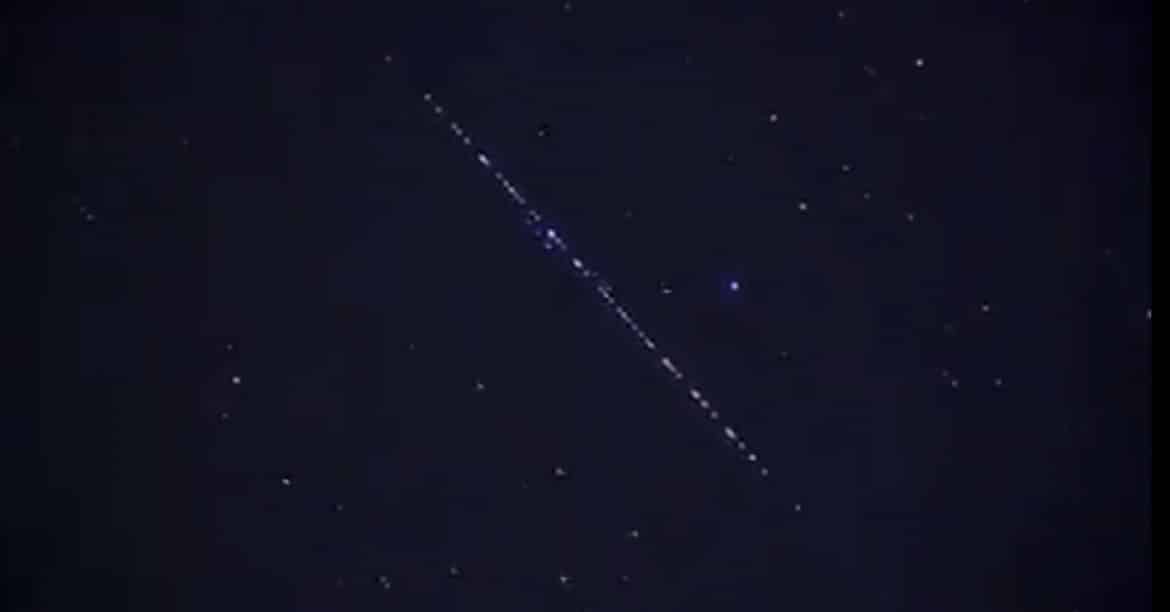Island resident Josh Holdgate was near Nantucket Memorial Airport Friday evening when he looked up and saw a sight unlike anything he had ever seen before. A trail of lights were moving together in a line across the sky.
“Definitely not identified,” he said.
After some Googling, Holdgate realized what he had seen was part of the Starlink satellite internet constellation recently launched by billionaire Elon Musk’s SpaceX to provide satellite Internet access. He wasn’t the only person who saw them on Nantucket and elsewhere in Massachusetts last Friday. There are already 1,600 Starlink satellites in low orbit around Earth, and thousands more are planned to be launched in the coming years.

While the Starlink satellites have been mistaken by some for UFOs and are a fascinating sight in the night sky, they are concerning to astronomers, including Dr. Regina Jorgenson, the Director of Astronomy at the Maria Mitchell Association on Nantucket.
“Of course, I have heard a lot about these – as they are a major issue/threat for astronomy,” Jorgenson said, citing the potential for interference with astronomical observations and light pollution in the night sky.
“From my understanding, it’s a bit of the ‘Wild West’ out there right now, because there are currently no (or not many, if any) regulations around what companies like SpaceX and Amazon can do with satellite constellations,” Jorgenson said in an email to the Current. “I think this is probably one of the most urgent ‘fronts’ for astronomers right now – working with governments to get regulations passed that will limit the detrimental effects of these satellites.”
Several astronomical organizations, including the American Astronomical Society and the International Astronomical Union, are working together to address the issue on a variety of fronts. But the satellites are already causing issues for both professional and amateur astronomers, prompting SpaceX to pledge to make the units it is preparing to launch less reflective than those now orbiting the Earth. Even so, Jorgenson said, less reflective satellites will still pose a problem.
“Lots of bright satellites streaking across the night’s skies will cause terrible interference with astronomical observations,” Jorgenson said. “Imagine taking a long exposure of the night sky – and suddenly a satellite constellation passes through your field of view! Now your image will be effectively useless, as, instead of being able to study the astronomical targets in detail, you have many bright streaks across your image. Obviously, this is a major problem for astronomers. Given this, these companies (SpaceX and Amazon, etc.) say that they are working to lower the ‘albedo’ of the satellites – which means that they are trying to make them less ’shiny’ or reflective. While this is good, it does not solve the problem completely – as, if you still have tens of thousands of dark satellites streaking across all parts of the sky – they will still show up in your astronomical images – but instead of causing bright streaks, they will cause ‘mini eclipses’ of stars (or whatever light source you are observing) as the dark satellites pass in front.”
The new non-profit advocacy group Nantucket Lights mentioned the Starlink satellite sightings over Nantucket in a post on Sunday, and stated that soon one out of every 15 points of light in the night sky will be satellite.
One specific astronomy program that could be impacted, Jorgenson said, is a survey being conducted at the Vera Rubin Observatory in Chile that aims to produce the deepest, widest image every captured of the universe.
“It will take images of the entire night sky (visible from that site) almost once per night and then repeat this every night,” Jorgenson said. “We can then ’stack’ these images to produce an even more sensitive image (and see very faint things) – but also, this can be used to find transient objects – things like supernova and other exciting objects that get bright and then dim with time. Unfortunately, a bunch of dark satellites roaming the night skies will be extremely problematic for this survey as these dark satellites passing in front of distant bright things (like stars) will mimic them blinking on and off, causing them to be flagged as transients (falsely). The astronomical community has a huge amount of funding invested in this observatory – so this can have a major impact on a major upcoming new project for astronomers – not to mention the huge negative impact on our possible future astronomical discoveries.”






